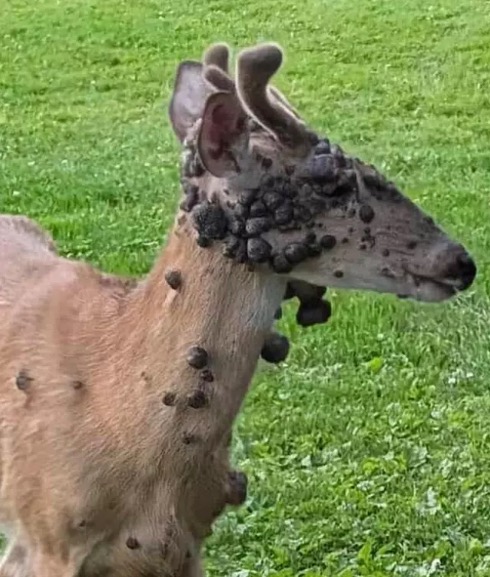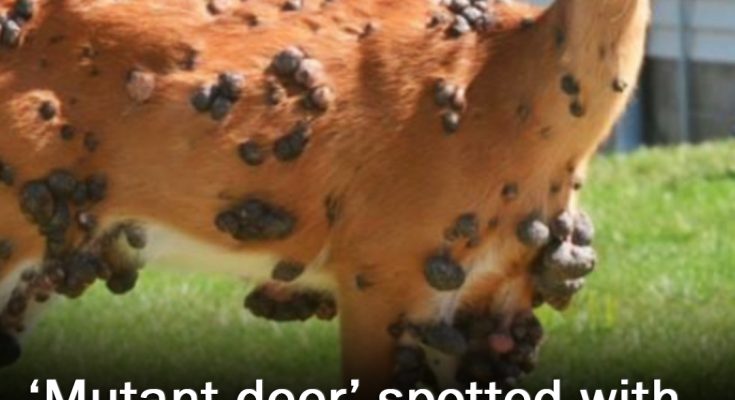
Just when you thought the creepy stories of Colorado’s so-called “Frankenstein rabbits” and “zombie squirrels” were enough nightmare fuel, a new unsettling sight is making the rounds online: deer covered in dark, warty “flesh bubbles.”
The bizarre-looking animals have been spotted in Pennsylvania and Wisconsin, with photos quickly spreading across social media.
One Reddit user shared a snapshot of a deer in their backyard, writing: “Not sure what’s wrong with her or how we can help. Gunshot wound? Tumor? Fireworks? Prion disease? Don’t know what to do.” Another user posted an image of a deer with lumps on its face and chest, simply asking: “What’s wrong with this deer?”

Turns out, there’s an explanation.
And while it looks terrifying, it isn’t quite the apocalypse.
What’s really going on?
Wildlife experts say the condition is called deer fibroma — caused by a species-specific papillomavirus. According to the Maine Department of Inland Fisheries and Wildlife: “These manifest as firm, warty growths fixed to the skin of a deer. They vary in size (though most are just a few centimeters in diameter), are typically dark in color and bare of fur, and often appear fissured or lumpy.”
Most deer only develop a handful of small fibromas, but larger, more widespread cases aren’t unusual. The good news? Deer fibroma isn’t contagious to humans or other animals outside the deer population.
How do deer spread it?
Dr. Kristin Mansfield, a wildlife veterinarian in Washington state, told FOX13 that deer pass the virus to each other by sharing space:
”Just like the human warts, they come from direct contact,” Dr. Manfield said.
”Maybe sharing the same rubbing post, maybe congregating where people are feeding them, and they’re in close contact.”
Like warts in humans, these growths might cause some itching for the deer — but that’s about it. And for hunters worried about the animal’s condition, the Washington Department of Fish and Wildlife says the meat is still safe to eat.

“They’re limited to the skin, and you can just cut them off,” Dr. Mansfield explained.
Although the growths themselves aren’t dangerous to humans, deer do carry ticks — which can spread illnesses like Lyme disease in communities where deer are abundant.
Thankfully, in most cases, a deer’s immune system fights the virus naturally, and the warts shrink and disappear over time.
Can it be treated?
There’s no real treatment for fibroma in wild deer.
For captive animals, the lumps can sometimes be removed surgically, but otherwise, experts recommend leaving infected deer alone. In rare situations where growths prevent a deer from eating, moving, or seeing, euthanasia is considered.
Why are we seeing more “mutant Animals”?
Experts believe climate change could be playing a role. Warmer temperatures allow mosquitoes and ticks — which help spread viruses and diseases — to thrive.
Dr. Omer Awan of the University of Maryland School of Medicine explained to The Daily Mail: “These temperature changes are resulting in diseases that were never endemic in certain areas to become endemic. If you take a look at Lyme disease, for example, we’re starting to see it in areas that we never saw it before… places like southern Canada, northern states on the East Coast, like Maine.”
And because more people are documenting these unusual cases online, Awan added, “People are starting to talk about it more, they’re starting to document it more on social media, and hence, there’s been a lot more discussion about this.”
So while the sight of “mutant deer” covered in bubbling growths may be shocking, experts say it’s not a threat to humans.
Still, the eerie trend of animals developing strange, virus-driven appearances across the U.S. has many wondering — is this just the start of something bigger?

